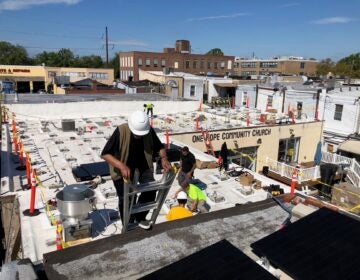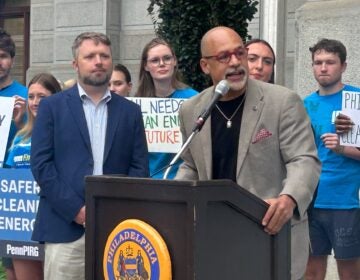With South Philadelphia refinery in bankruptcy proceedings, neighbors see an opportunity for cleaner air
The refinery is Philadelphia’s single largest generator of particulate emission air pollution, according to city data.
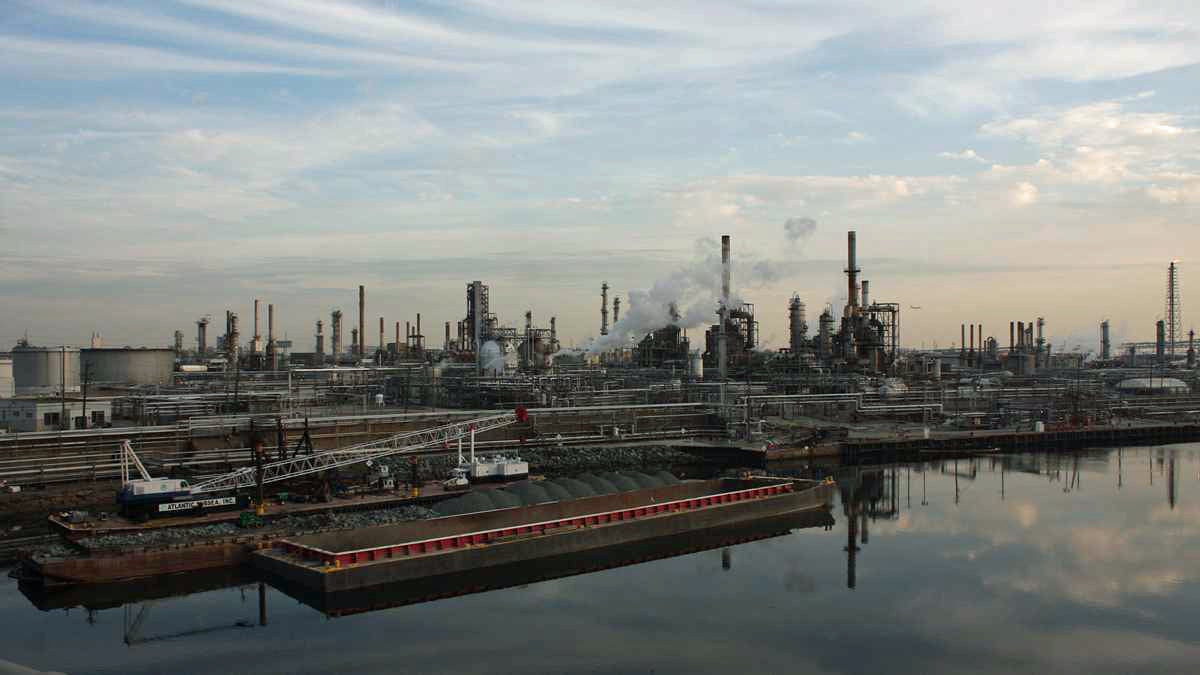
Philadelphia Energy Solutions' Point Breeze refinery along the Schuylkill River in Philadelphia. (Kellie McGinn/Philadelphia Energy Solutions)
Zalaka Thompson lives less than a mile from the biggest oil refinery on the East Coast. Though the Schuylkill Expressway separates her home from the Philadelphia Energy Solutions (PES) crude facility, she feels its presence daily. Her 14-year old son has asthma and carries an inhaler with him at all times, on the doctor’s orders. And some mornings, she can’t keep her windows open for long without smelling gas or sulfur. “I like to open my windows for fresh air, but sometimes I have to close them,” she says.
The refinery is Philadelphia’s single largest generator of particulate emission air pollution, according to city data. In the 19145 zip code that Thompson and her son call home, asthma is common among children, and the rates of hospitalization for the ailment are among the highest in the city. The cancer mortality rate too is among the highest in the city.
Earlier this month, after years of financial strain since oil prices dropped several years ago, PES filed for bankruptcy It blames its most recent financial problems on EPA requirements they say have driven up costs. PES CEO Greg Gatta describes the bankruptcy filing as a restructuring of debt that “positions PES well for the future with a sustainable capital structure and additional liquidity.”
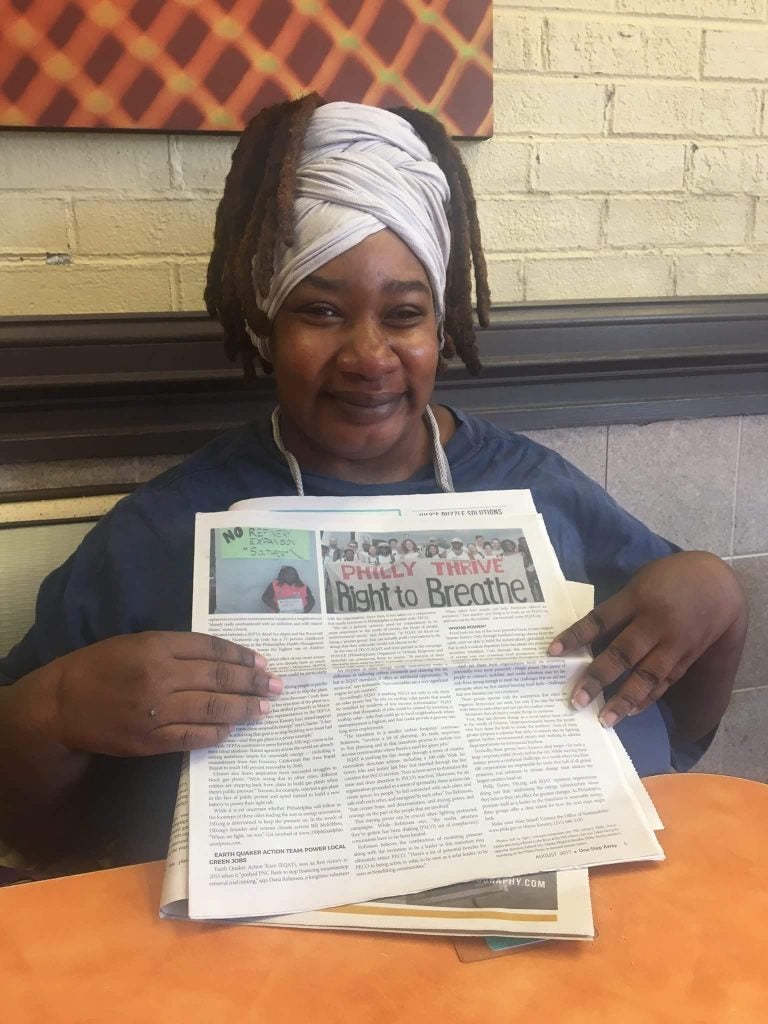
But even as PES moves towards financial sustainability, neighbors like Thompson say the corporation isn’t doing enough to reduce its environmental impact locally. She hopes the bankruptcy will inspire the company to rethink how it does business across the board. Since last year, the Philadelphian has been working with Philly Thrive, a local environmental community organization, in a campaign to raise awareness about the refinery’s public health costs. In November, the group scored a win when Philadelphia’s new Clean Energy Vision draft stipulated the need of a city-wide conversation lead by the Office of Sustainability “to determine the future of the South Philadelphia oil refinery” in light of city’s goal to reduce carbon pollution 80 percent by 2050.
“The refinery is the single-largest source of particulate emissions in the city and alone accounts for nearly 16 percent of Philadelphia’s carbon footprint, not including the fossil fuel products exported off-site,” reads the document. “OOS is committed to leading a citywide conversation on the role of PES and other heavy industry as we move toward a clean-energy future.”
Christine Knapp directs the Office of Sustainability. She says the city is committed to leading a conversation about the refinery and its contribution to climate change and local health problems, though the agency won’t make particular recommendations until the final plan is published.
“It means the work we made was heard,” Thompson said about the city’s decision. “I thought we couldn’t do anything about it.”
The cost of dirty air
Philly Thrive started surveying the refinery’s neighbors last May and found that among 314 respondents, more than half of them had either heart disease, cancer, or a respiratory condition. Almost 34 percent of them had asthma, which is higher than the 19 percent asthma prevalence in Philadelphia and the national average of about 8 percent.
Alexa Ross, a 27-year-old Southwest Philadelphia resident and staff organizer at Philly Thrive, said they started surveying neighbors after attending an Office of Sustainability listening session intended to capture residents’ priorities for Philadelphia’s energy future. Ross said they noticed the role of the refinery was not being discussed.
“The EPA has classified PES a high-priority violator since April 2012, and in significant noncompliance with the Clean Air Act and Clean Water Act,” Ross says. “It’s baffling to us that such a major source of pollution is just really absent from the conversation, given the asthma rates in the city.”
According to the survey’s report, 82 percent of the neighbors had negative feelings about the refinery, considering dangerous and a health hazard. Asked about what they would like to see happen if the refinery shuts down, most of them said the site should be clean and made safe, and that the refinery should pay for damages.
Carol Scott, 71-years-old, moved to a Philadelphia Housing Authority senior center about a mile from the refinery ten months ago. She’s not happy about her new home. She has asthma and said she’s been wheezing a little more recently. She can see the refinery’s smoke from her window. “It’s just all over,” she says. But what worries her the most are the trains transporting highly flammable crude oil to the refinery, also called bomb trains.
“It’s a blessing that the city is caring about this refinery and the trains that run by it,” Scott says. “I look out my window and see those trains, going up and down 24 hours a day — and it blows the horn! It would be a blessing when something be done with it; for the seniors, for the children, for all of us who are involved. It would be a blessing to see some changes to be made.”
Peter DeCarlo is a climate and air pollution scientist at Drexel University. He has studied the pollutants — chemicals like benzene, toluene and xylene— lurking in the clouds Scott sees from her window.
“These are gases — these are not typically particles — and are known to be carcinogenic, which means they cause cancer, and they are a byproduct of the refining process,” DeCarlo says. “We clearly see elevated levels of these pollutants in the immediate area of the refinery, and as they go downwind, they’re going to dilute [into the air].”
His measurements also show higher emissions of methane, another noxious gas, next to the refinery.
“The refinery is a massive, massive facility and its emissions are going to dwarf the emissions for something like the Nicetown power plant,” says DeCarlo, referring to Septa’s natural gas recently opposed by local environmentalist.
In an EPA screening-level model that analyzes factors that contribute to human health risk — the amount of chemical released, the degree of toxicity, and the size of the exposed population — the PES refinery has a score almost 10,000 times higher than the petrochemical industry median. DeCarlo compared the overall volatile organic compounds (VOC) emissions coming from the Marcellus Shale activities in Pennsylvania and those coming from the refinery and found they were roughly the same.
DeCarlo argues PES is not doing the measurements with the precision required by a consent decree, and it’s putting together measures of methane and VOCs. The methodology is problematic because it masks VOCs measurements, which can cause cancer. Last October, he exposed the matter to the Philadelphia’s Health Department Air Pollution Control Board. James Garrow, a spokesperson for the agency, said in an email that PES is held to the standard demanded by the consent decree.
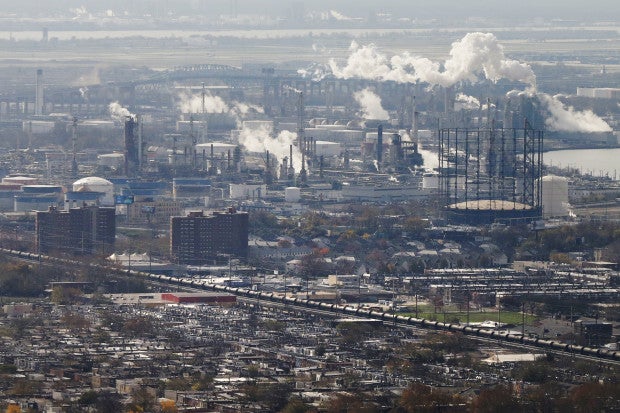
An uphill battle
Office of Sustainability’ Knapp, doesn’t dispute that more could be done on a regulatory level to protect residents like Thompson and Scott. When she was working with the Clean Water Fund in 2005, her organization and others sued the refinery for “years of environmental violations” that exposed residents to pollution emissions, flaring, and foul odors. She says the city will continue to ensure that PES comply with all air emission laws and permits and “look for opportunities where the city can advocate for stronger regulatory standards at the state and federal levels.”
But Knapp may be in for an uphill battle. At a time when the city is fighting to hold onto jobs and a shrinking manufacturing sector, the sustainability’s officer’s boss, Mayor Jim Kenney, may find his priorities tested. In 2012, the private equity group Carlyle and Energy Transfer Partners rescued the refinery from bankruptcy, in a deal supported by a state taxpayer-funded package, which included a tax-free zone, more than $25 million in grants and environmental liability waivers. Last year Reuters reported that a spokesperson for Kenney said the public support was justified “because it meant that the refinery remained opened and nearly 1,000 jobs stayed in Philadelphia.”
Of those nearly 1,000 jobs, 15 to 20 percent are held by people who live inside city limits, according to Cherice Corley, a PES spokesperson. “With family-sustaining jobs earning $100K+ per year,” many move to the suburbs after a few years, she wrote in an email. PES is also starting a program for skilled trades targeted to local talent, Corley said.
Ross, Philly Thrive’s organizer, said since she’s been knocking on doors near the refinery in 2015, she has only met one neighbor working as an engineer with the refinery and a couple of residents working at the cafeteria.
“The most common response to that question — do you work for the refinery or know someone who does — was people laughing at us,” Ross said. “Most people do not know anybody who works there.”
PES’ Corley said the refinery supports the South Philly Hurricanes Youth Athletic Association, the Southwest pride day, Bartram’s River Festival, the South Philly Business Association scholarship program, among other community groups and events hosted by councilmember Kenyatta Johnson and State Rep. Jordan Harris (D-Philadelphia).
Clean Air Council’s Russell Zerbo says that he thinks the refinery is experiencing pressure not only from the market but also by public health organization like Thrive and his own, which sued PES in 2012.
“But time and time again people come out of the woodworks to keep the refinery open,” Zerbo says. “Lots of elected officials… Even though Philly has this incredibly high asthma rates and the refinery breaks environmental regulations all the time, there’s a lot of will in the city to keep the refinery open.”
Irene Russell is 66 years old and has lived in Grays Ferry all her life. She said her daughter and a couple of her grandsons have asthma, and that some friends have died of cancer. She blames it on the refinery but says she’ll never move out of her neighborhood. “If I’m not in Grays Ferry, then I’m nowhere in Philadelphia — I’ll rather go to Florida,” Russell said.
Still, the refinery needs to be taken accountable, she says. “It’s too many things connected with it that are just done with no thought to the people who would be impacted by it, and I don’t think that’s right,” Russell said. “The air you breathe is not something that you have a choice; you have to breathe. So if it’s damaging us, it has to change.”
WHYY is your source for fact-based, in-depth journalism and information. As a nonprofit organization, we rely on financial support from readers like you. Please give today.




